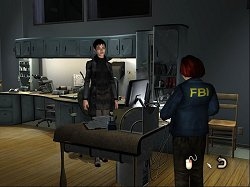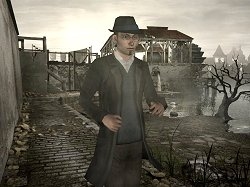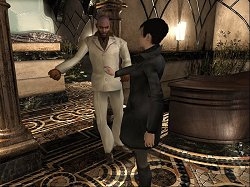|
Still Life
 Still Life can almost be described as a sequel to Post Mortem in that we get to catch up with Gustav McPherson again as he investigates a series of bloody murders in Prague in the late 1920s. On the other hand it is more than a sequel as this story also follows the exploits of Victoria McPherson, Gus' granddaughter in modern day Chicago. Victoria is a profiler with the FBI and she too is on the trail of a vicious serial killer. The two investigations, Prague and Chicago, proceed in tandem and overlap as the chilling similarities between them become more and more apparent. Still Life can almost be described as a sequel to Post Mortem in that we get to catch up with Gustav McPherson again as he investigates a series of bloody murders in Prague in the late 1920s. On the other hand it is more than a sequel as this story also follows the exploits of Victoria McPherson, Gus' granddaughter in modern day Chicago. Victoria is a profiler with the FBI and she too is on the trail of a vicious serial killer. The two investigations, Prague and Chicago, proceed in tandem and overlap as the chilling similarities between them become more and more apparent.
As pointed out in the preview of this game, you don't need to have played Post Mortem to understand what is happening in Still Life as a lot of Gus' background is revealed as you play. And, of course, we are meeting Victoria for the first time.
Paintings figure prominently in this investigation, as do the mutilation killings of young women prostitutes. There is a warning that the game has some gore, nudity (the bodies of women victims), strong language and mature themes, so you can't say you haven't been warned. It's a dark, disturbing tale, lightened by some humour and the noble investigations of the two main characters. I liked the portrayal of both Gus and Victoria. Gus is quiet, sensitive and concerned for the victims, as well as being anxious for the safety of other 'ladies of the night'. Victoria is modern, independent, and sassy, but equally concerned for the victims. Both are adamant that the killer must be stopped before he strikes again.
The killer is portrayed as the archetypal Jack the Ripper. A menacing, shadowy figure wearing a top hat and cape, his face always hidden behind a silver mask.
 There is much to admire in Still Life. A strong parallel narrative, a powerful introduction, excellent graphics, music, ambient sounds, and some stunning cut scenes. The two scenes where Victoria pursues the killer are particularly gripping with the music revving up and Victoria showing that she's not afraid of a bit of action. There isn't music throughout the game, but it always fits the scene nicely and is used effectively to heighten the tension.
The attention to detail is impressive. An example from early in the game shows Victoria distributing cups of coffee from a tray. As each cup is taken it is clear that those remaining on the tray are reduced by one. There are other small details to appreciate too; rats scurrying around in ratty places, and in night-time Prague shadowy figures appear in lighted windows intermittently.
All this contributes to build up a great atmosphere, along with the misty streets of Prague, the gaudy decor of a certain adult location, and wintery Chicago where light snow gently falls. The close-ups of Gus, and Victoria in particular, also inject feeling into the characters and into the game. There is much to admire in Still Life. A strong parallel narrative, a powerful introduction, excellent graphics, music, ambient sounds, and some stunning cut scenes. The two scenes where Victoria pursues the killer are particularly gripping with the music revving up and Victoria showing that she's not afraid of a bit of action. There isn't music throughout the game, but it always fits the scene nicely and is used effectively to heighten the tension.
The attention to detail is impressive. An example from early in the game shows Victoria distributing cups of coffee from a tray. As each cup is taken it is clear that those remaining on the tray are reduced by one. There are other small details to appreciate too; rats scurrying around in ratty places, and in night-time Prague shadowy figures appear in lighted windows intermittently.
All this contributes to build up a great atmosphere, along with the misty streets of Prague, the gaudy decor of a certain adult location, and wintery Chicago where light snow gently falls. The close-ups of Gus, and Victoria in particular, also inject feeling into the characters and into the game.
Still Life is a third person perspective adventure and you get to stay in touch with Victoria and Gus as they explore their respective locations, seeking clues and talking to other characters. The interface is mouse controlled, navigation is easy point and click, and you can get Victoria and Gus to run by double clicking.
Using items is straight forward as long as you are standing close enough to the object you wish to use them on. A hand icon appears at the top left of the screen to alert you when you are close enough. A right click opens your inventory where you can select items to examine in detail and magnify and rotate them for even more careful scrutiny. Here you can also combine items, read your journal and case files as well as access the usual options for saving, loading and quitting. As far as I could tell saves are not limited, except maybe by your available disk space.
 Being an investigative game conversations are important, and these are streamlined in Still Life. Unlike many similar games, you don't get to select a question from a dialogue tree, you simply click through the conversation when the mouse icon appears in the bottom right of the screen. My first reaction to this was not favourable as I thought it was too much of the 'click now' approach to interactivity, but it worked very well making the conversation appear to flow spontaneously.
There is, in fact, some opportunity to influence conversations as left or right clicking have differing functions and at times the mouse icon indicates that you have a choice. Basically, left clicking lets you cut to the chase so the questions Gus or Victoria ask are straight to the point. Right clicking when the option is there allows for more 'off topic' meandering. You won't miss anything crucial no matter what choice you make.
One of the reasons the dialogue works so well in Still Life is because it's well written, so natural sounding. Some of it is quite clever. One exchange between Victoria and her colleague, Agent Miller, particularly appealed to me. They were searching the bedroom of a young male college student when Miller comments, "This guy is twisted ... gore films, crime scene photos, porn ..." To which Victoria replies, "You've just described three quarters of adolescent America ... We aren't here for character assassination. We'll leave that part to the lawyers". There are other examples too, showing that a lot of work has been put into characterisation and making Gus and Victoria feel like real people.
Added to this the voice acting is very good overall, only the delivery of one or two minor characters could have been better. The strong language is not overdone but the use of one particularly ugly expletive grated on me. Perhaps my ears are not yet sufficiently desensitised to such language. Being an investigative game conversations are important, and these are streamlined in Still Life. Unlike many similar games, you don't get to select a question from a dialogue tree, you simply click through the conversation when the mouse icon appears in the bottom right of the screen. My first reaction to this was not favourable as I thought it was too much of the 'click now' approach to interactivity, but it worked very well making the conversation appear to flow spontaneously.
There is, in fact, some opportunity to influence conversations as left or right clicking have differing functions and at times the mouse icon indicates that you have a choice. Basically, left clicking lets you cut to the chase so the questions Gus or Victoria ask are straight to the point. Right clicking when the option is there allows for more 'off topic' meandering. You won't miss anything crucial no matter what choice you make.
One of the reasons the dialogue works so well in Still Life is because it's well written, so natural sounding. Some of it is quite clever. One exchange between Victoria and her colleague, Agent Miller, particularly appealed to me. They were searching the bedroom of a young male college student when Miller comments, "This guy is twisted ... gore films, crime scene photos, porn ..." To which Victoria replies, "You've just described three quarters of adolescent America ... We aren't here for character assassination. We'll leave that part to the lawyers". There are other examples too, showing that a lot of work has been put into characterisation and making Gus and Victoria feel like real people.
Added to this the voice acting is very good overall, only the delivery of one or two minor characters could have been better. The strong language is not overdone but the use of one particularly ugly expletive grated on me. Perhaps my ears are not yet sufficiently desensitised to such language.
The characters and story are the strengths of Still Life, they drive the game along. So much so that one event leads strongly on to the next, there is rarely any doubt as to what to do or where to go. In fact more often that not the next step is spelled out in the dialogue which means that the player is always following along rather than being presented with investigative challenges to move forward. I thought that a little less direction would have been good and, perhaps, a little more emphasis put on the problem solving.
One particular 'puzzle' struck me as being a bit of an after thought, decoding a cookie recipe and making cookies. It wasn't difficult, but seemed out of place in a taut thriller centring on the urgent pursuit of a vicious serial killer. Such a puzzle may be fine for Nancy Drew but it jarred in this game. It may just be me but I thought that there was more scope for meaningful interaction in this investigation than the game actually allowed. This is not to say that there is little to do, far from it, and there are some good challenges. I just thought that the balance between the need to tell a compelling story and allowing the player to uncover it by overcoming obstacles to progress could have been better.
Much of the familiar adventuring in Still Life such as finding and using items is fairly easy. A couple of abstract logic puzzles are more challenging especially the lock picking and I am sure this one will catch out some players. Another puzzle that will cause frustration for some involves remotely controlling a spider-like robot to avoid deadly laser beams. As with all such puzzles, practice makes perfect, and at least it wasn't a timed sequence though you do have to time your movements to avoid the moving beams. There are also a couple of sliders and a mild maze to negotiate.
The game comes on 2 CDs and uses the Starforce copy protection system that seems to have caused grief for some people in other games but I have to say that so far I haven't had a problem with it. From the main menu you can recap on the transitions and cutscenes and you have the option of enabling subtitles for all dialogue including incidental remarks made by Victoria and Gus.
Still Life is a suitably gripping and atmospheric thriller and the transitions between the Chicago and Prague investigations are very smooth. Despite my few criticisms I really enjoyed playing it and I know that many adventurers who appreciate a strong story will equally enjoy it. The ending has a resolution of sorts but much is left unanswered. It seems clearly set up for a sequel that may never eventuate now that MC2-Microids has been taken over, but who knows? I'd certainly like to do some more investigating with Gus or Victoria.
See the metzomagic.com Still Life walkthrough.
Copyright © Gordon Aplin 2005.
All rights reserved.
System Requirements:
Win 98/ME/2000/XP, Pentium III 800 Mhz (1.0 Ghz recommended), 32 MB DirectX 8.1 compatible 3D video card (NVidia GeForce Series or ATI Radeon Series Video Card of equivalent recommended), 128 MB RAM (256 MB recommended), 600 MB free hard disk space (1200 MB recommended) 16x CD ROM Drive (24x recommended) DirectX Compatible sound card.
|

